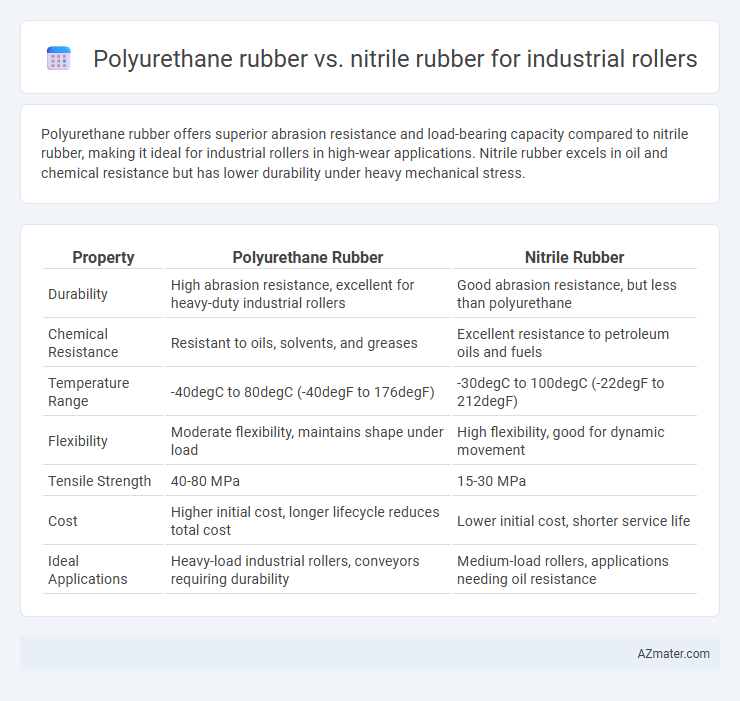Polyurethane rubber offers superior abrasion resistance and load-bearing capacity compared to nitrile rubber, making it ideal for industrial rollers in high-wear applications. Nitrile rubber excels in oil and chemical resistance but has lower durability under heavy mechanical stress.
Table of Comparison
| Property | Polyurethane Rubber | Nitrile Rubber |
|---|---|---|
| Durability | High abrasion resistance, excellent for heavy-duty industrial rollers | Good abrasion resistance, but less than polyurethane |
| Chemical Resistance | Resistant to oils, solvents, and greases | Excellent resistance to petroleum oils and fuels |
| Temperature Range | -40degC to 80degC (-40degF to 176degF) | -30degC to 100degC (-22degF to 212degF) |
| Flexibility | Moderate flexibility, maintains shape under load | High flexibility, good for dynamic movement |
| Tensile Strength | 40-80 MPa | 15-30 MPa |
| Cost | Higher initial cost, longer lifecycle reduces total cost | Lower initial cost, shorter service life |
| Ideal Applications | Heavy-load industrial rollers, conveyors requiring durability | Medium-load rollers, applications needing oil resistance |
Overview of Polyurethane Rubber and Nitrile Rubber
Polyurethane rubber offers exceptional abrasion resistance, load-bearing capacity, and elasticity, making it ideal for high-performance industrial rollers exposed to heavy wear. Nitrile rubber excels in oil, fuel, and chemical resistance, providing durable performance in environments where exposure to petroleum-based substances is common. Industrial applications prioritize polyurethane for mechanical strength, while nitrile is favored for chemical resilience in roller manufacturing.
Key Material Properties Comparison
Polyurethane rubber offers superior abrasion resistance, high tensile strength, and excellent load-bearing capacity, making it ideal for industrial rollers subjected to heavy wear and mechanical stress. Nitrile rubber provides outstanding oil and chemical resistance alongside good flexibility at low temperatures, suitable for environments with exposure to oils, fuels, and solvents. The selection between polyurethane and nitrile rubber depends on specific operational demands such as wear resistance versus chemical compatibility in industrial roller applications.
Abrasion and Wear Resistance
Polyurethane rubber exhibits superior abrasion resistance compared to nitrile rubber, making it ideal for industrial rollers exposed to high friction and heavy wear conditions. Nitrile rubber, while offering good chemical resistance, tends to wear faster under abrasive environments, limiting its durability for heavy-duty roller applications. Polyurethane's enhanced toughness and elasticity contribute to longer service life and reduced maintenance costs in industrial rolling processes.
Chemical and Oil Resistance
Polyurethane rubber offers superior abrasion resistance and excellent mechanical strength but has moderate resistance to oils and chemicals, making it less ideal for environments with heavy exposure to hydrocarbons. Nitrile rubber excels in chemical and oil resistance, particularly against petroleum-based oils and fuels, providing enhanced durability in industrial rollers subject to aggressive chemical exposure. Selecting nitrile rubber for industrial rollers ensures prolonged service life and performance in applications involving high oil and chemical contact compared to polyurethane alternatives.
Temperature Stability and Performance
Polyurethane rubber offers superior temperature stability, maintaining elasticity and wear resistance in a range from -40degC to 100degC, making it ideal for high-load industrial roller applications. Nitrile rubber, with its excellent resistance to oil and temperature ranges of -30degC to 120degC, excels in environments with exposure to hydrocarbons and moderate thermal stress. Choosing between polyurethane and nitrile for industrial rollers depends on the balance between temperature demands and chemical exposure, with polyurethane favored for abrasion and wear resistance, and nitrile preferred for oil resistance and higher temperature tolerance.
Load-Bearing Capacity
Polyurethane rubber offers superior load-bearing capacity for industrial rollers due to its high tensile strength and excellent abrasion resistance, supporting heavy-duty applications with minimal deformation. Nitrile rubber, while providing good chemical resistance and moderate load capacity, is less effective under extreme pressure and prolonged mechanical stress. Choosing polyurethane ensures enhanced durability and performance in heavy-load environments, critical for industrial roller longevity and efficiency.
Applications in Industrial Rollers
Polyurethane rubber offers superior abrasion resistance, high load-bearing capacity, and excellent elasticity, making it ideal for industrial rollers used in printing, packaging, and metal processing industries where durability and precision are critical. Nitrile rubber provides excellent oil, fuel, and chemical resistance, making it suitable for industrial rollers operating in environments with exposure to lubricants and harsh chemicals, such as automotive manufacturing and conveyor systems. Choosing between polyurethane and nitrile rubber depends on specific operational demands, including wear resistance versus chemical exposure, to optimize roller performance and lifespan.
Cost Efficiency and Lifespan Analysis
Polyurethane rubber offers superior wear resistance and higher load-bearing capacity, extending the lifespan of industrial rollers and reducing replacement frequency compared to nitrile rubber. Nitrile rubber presents a lower upfront cost but often requires more frequent maintenance and replacement due to its lesser abrasion and chemical resistance. Evaluating total cost of ownership, polyurethane provides better cost efficiency for heavy-duty applications, while nitrile suits low to moderate stress environments where initial budget constraints dominate.
Maintenance and Replacement Considerations
Polyurethane rubber offers superior abrasion resistance and longer service life in industrial roller applications, reducing the frequency of maintenance and replacement compared to nitrile rubber. Nitrile rubber, while providing excellent oil and chemical resistance, tends to wear faster under heavy mechanical stress, necessitating more frequent inspections and part replacements. Selecting polyurethane rubber enhances operational efficiency by minimizing downtime and maintenance costs in harsh industrial environments.
Choosing the Right Rubber for Your Industrial Rollers
Polyurethane rubber offers superior abrasion resistance and load-bearing capacity, making it ideal for industrial rollers exposed to heavy wear and high mechanical stress. Nitrile rubber excels in oil, fuel, and chemical resistance, providing durability in environments with frequent exposure to hydrocarbons and solvents. Selecting the right rubber depends on the roller's operating conditions, where polyurethane suits high-wear applications and nitrile fits best for chemical and oil resistance requirements.

Infographic: Polyurethane rubber vs Nitrile rubber for Industrial roller
 azmater.com
azmater.com